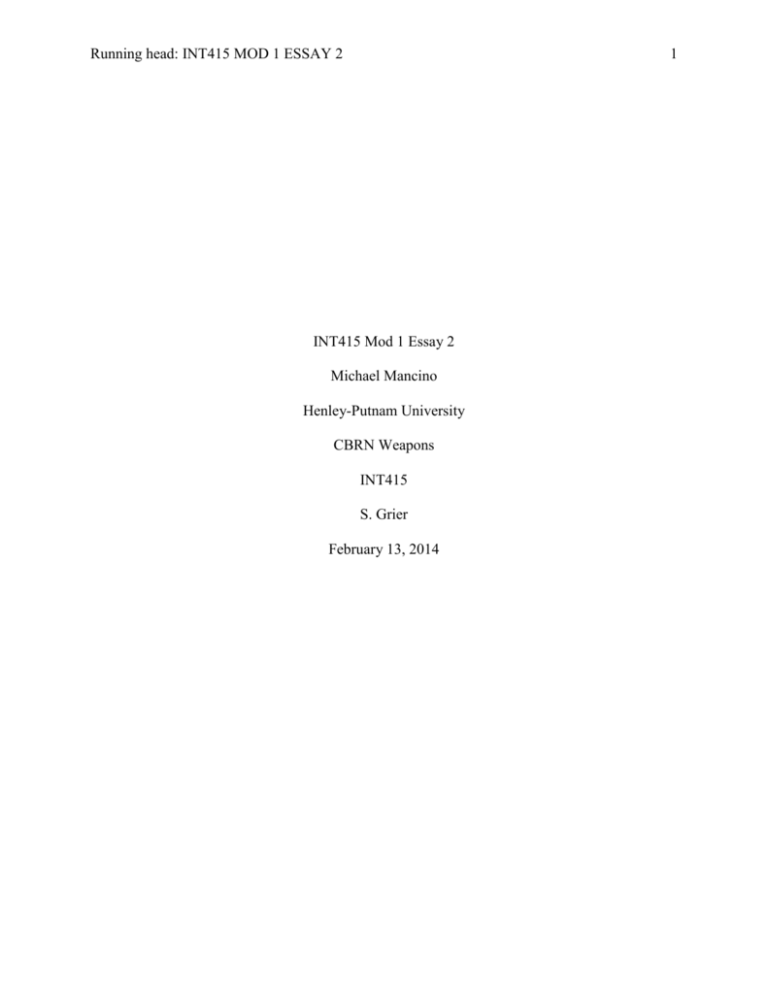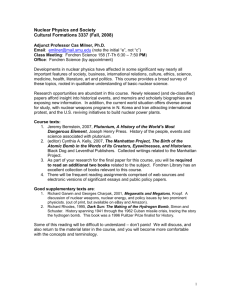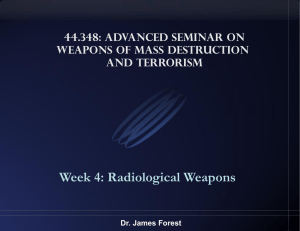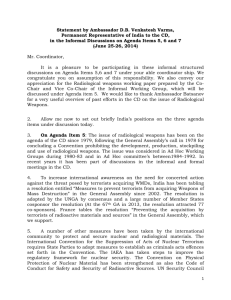INT415 Mod 1 Essay 2
advertisement

Running head: INT415 MOD 1 ESSAY 2 1 INT415 Mod 1 Essay 2 Michael Mancino Henley-Putnam University CBRN Weapons INT415 S. Grier February 13, 2014 INT415 MOD 1 ESSAY 2 2 INT415 Mod 1 Essay 2 From the beginning of mankind’s attainment of consciousness it would seem that we are determined to kill one another. From humble beginnings of thrown stones and beating sticks, he has sought ways to make himself a more efficient killer. There have been many periods throughout history where weapons have forced a paradigm shift in conquest and warfare. From the invention of bladed weapons, to the English longbow; crossbows and gunpowder, man is forever inventing more innovative ways to kill. The most significant shift came in the 1940’s when man was able to harness the power of the atom. With the development and use of the Fat Man and Little Boy a new era of destruction was realized. Nuclear weapons, if not respected, have the capability to reign in destruction the likes of which could literally end life on earth. A lesser, yet likely, byproduct of the nuclear age was the realization that the destructive power of radiation could be harnessed in a much simpler form. Antagonists without the ability to obtain or construct a nuclear weapon now have the option to construct radiological weapons. Using byproducts spanning from medical radiological waste to lost or stolen radioactive material on the black market, terrorists and criminals can construct a weapon that is capable of dispersing harmful radiation over a wide area. A nuclear weapon is a device designed to release energy in an explosive manner as a result of nuclear fission, fusion, or a combination of the two (Encyclopedia Britannica, n.d.). Just before the beginning of World War 2 Albert Einstein, and several other German scientists, informed President Truman of Nazi efforts to purify uranium-235 which could be used to construct a viable nuclear weapon (About.com - Inventors, n.d.). Shortly after, the United States began the Manhattan Project with the goal of expediting research and construction of a bomb of its own. The major challenge in creating an atomic weapon is the separation of u-238 and u-235 INT415 MOD 1 ESSAY 2 3 isotopes. Once a method was developed to achieve this, scientists were able to ultimately design two forms of ignition for the material: a gun device and an implosion device. As the first suggests, a small bit of fissionable material is propelled down a barrel by explosive materials where it impacts another amount of fissionable material. The impact would thus result in a fission reaction and explosion. The other method, the implosion device, is much more complex. In the most simplistic terms, an implosion device contains a core of fissile material surrounded by a globe of high explosives with a bit of dead space in between. The high explosives, once detonated, create a shock wave which focuses tremendous force on the core of fissionable material, causing it to implode which then results in the fission of the core. Without going into technical detail, the power of a nuclear explosion is a combination of blast, thermal pulse, neutron, x-ray and gamma ray emission, radiation and electromagnetic pulse. Most associate the power of a nuclear bomb with the visual effects of the explosion, which to be sure, are devastating. However, the lingering effects of radiation make the further occupation of the area difficult and costly. If one were not able to procure or build a functioning nuclear weapon but desire to inflict a large amount of damage and disruption via radiation, the next logical step would be the construction of a radiological device. A radiological weapon, or radiological dispersion device (RDD), is any weapon that is designed to spread radioactive material, with intent to kill or cause disruption, upon a city or nation (Princeton, n.d.). Colloquially, these weapons are known as dirty bombs. Terrorist organizations, such as Al Qaeda (AQ), have long been suspected of intending to deploy a dirty bomb against American interests. The effect of such a weapon depends on several factors, including the type and amount of radiological material used. Material produced in reactors would likely be a preferred source amongst a criminal or terrorist INT415 MOD 1 ESSAY 2 4 organization but these would also be the most difficult to procure. An ideal source, then, would be those organizations that produce radioactive material for use in medical or industrial applications. It would still be difficult to procure these materials directly from a producer. However, those intent on doing so may focus on what is called an orphan source (Ferguson, Kazi, & Perera, 2003). Orphan sources are radioactive sources outside of institutional control. Whether they were lost or simply improperly disposed of is largely irrelevant. The fact that they are unaccounted for or sparsely protected makes them an attractive source for potential misuse. There are thousands of orphan sources throughout the world and they are a serious potential threat (Nuclear Threat Initiative, n.d.) One of the most known cases of a suspected plot by a terrorist organization to deploy a dirty bomb was the case of Jose Padilla, also known as Abdullah al-Muhajir or Muhajir Abdullah, and his association with Al Qaeda. Jose Padilla traveled to Egypt in 1998. While on a Hajj, or pilgrimage, to Saudi Arabia in 2000 he came in contact with an Al Qaeda recruiter from Yemen where he subsequently traveled to and stayed for some time. During his stay in Yemen this recruiter arranged for him to attend training in Afghanistan ("Padilla Summary," ). Following an initial term of service in Afghanistan Padilla subsequently proposed a dirty bomb operation to his superiors. Padilla returned to the United States on May 8, 2002 where he was held arrested. As far as Al Qaeda and the pursuit of an RDD, information exists that suggests AQ has sought to acquire nuclear and radiological material from sources ranging from Chechen separatists to Kazakh stockpiles left over from the cold war(Salama & Hansell, 2005). Whether or not AQ is able to carry out an attack in the US is debatable, however their ability to build a device doesn’t seem to be a point of contention. The threat from radiological weapons is definitely a legitimate concern. Whether or not it is Al Qaeda or a domestic antagonist makes INT415 MOD 1 ESSAY 2 5 little difference. Radiological material from orphan sources is especially concerning. If it is indeed as easy to acquire as suggested, adding it to a conventional explosive would appear to be a matter of ease. Media coverage in the Jose Padilla case has been extensive, but there is little focus to be found on the plan to attack the United States with a dirty bomb. Most of the coverage focuses on Padilla’s detention and trial and the accused unconstitutionality of it. Much of the source material gathered from media sources only mention the dirty bomb in passing as an alleged plan. Time even went so far as to accuse a Senator of grandstanding when describing the threat of an RDD (Ripley, 2002). In contrast to much of the course material, the media is doing what the media does: sensationalizing one aspect of a situation, probably with the intent of raising ratings, in lieu of giving out useful information such as the threat of radiological warfare. Nuclear and radiological threats are a continuous concern for national security in the United States. Despite efforts at non-proliferation, people will continue to experiment with and develop ever more innovative ways to kill one another. Radiological weapons especially will be an ever increasing threat against U.S. interests as long as there are stateless groups, actors and terrorists with relatively easy access to harmful materials. Groups such as Al Qaeda and its subsidiaries are determined to find more effective means of delivering their brand of contempt and malice and will continue to plot ever more devastating means of attack. It is in the best interest of all concerned to limit the access and production capability of these types of weapons by implementing proper control and disposal of potentially dangerous material. INT415 MOD 1 ESSAY 2 6 References About.com - Inventors. (n.d.). http://inventors.about.com/od/astartinventions/a/atomic_bomb.htm Encyclopedia Britannica. (n.d.). www.britannica.com/EBchecked/topic/421827/nuclear-weapon Federation of American Scientists. (n.d.). http://www.fas.org/nuke/intro/nuke/ Ferguson, C., Kazi, T., & Perera, J. (2003). Commercial Radioactive Sources: Surveying the Security Risks. Retrieved from Monterey Institute for International Studies: Center for Nonproliferation Studies: http://cns.miis.edu/opapers/op11/op11.pdf Nuclear Threat Initiative. (n.d.). http://www.nti.org/threats/radiological/ Princeton. (n.d.). http://www.princeton.edu/~achaney/tmve/wiki100k/docs/Radiological_weapon.html Profile: Jose Padilla. (2007, 08/16/2007). BBC News. Retrieved from http://news.bbc.co.uk/2/hi/americas/2037444.stm Ripley, A. (2002, 06/16/2002). The Case of the Dirty Bomber. Time Magazine. Retrieved from http://content.time.com/time/nation/article/0,8599,262917,00.html Rosenthal, A. (2012, 05/03/2012). Tortured Logic. New York Times. Retrieved from http://takingnote.blogs.nytimes.com/2012/05/03/torturedlogic/?_php=true&_type=blogs&_r=0 Salama, S., & Hansell, L. (2005). Does Intent Equal Capability: Al Qaeda and Weapons of Mass Destruction. Retrieved from Monterey Institute of International Studies : http://cns.miis.edu/npr/pdfs/123salama.pdf Summary of Jose Padilla’s Activities with Al Qaeda. (). Retrieved from http://www.fas.org/irp/news/2004/06/padilla060104.pdf INT415 MOD 1 ESSAY 2 Summit County Health Department. (n.d.). http://www.summitcountyhealth.org/adults/emergency-preparedness/public-healthplanning-re ‘Beyond Debate’. (2012, 05/03/2012). New York Times. Retrieved from http://www.nytimes.com/2012/05/04/opinion/beyonddebate.html?ref=josepadilla&_r=2& 7





